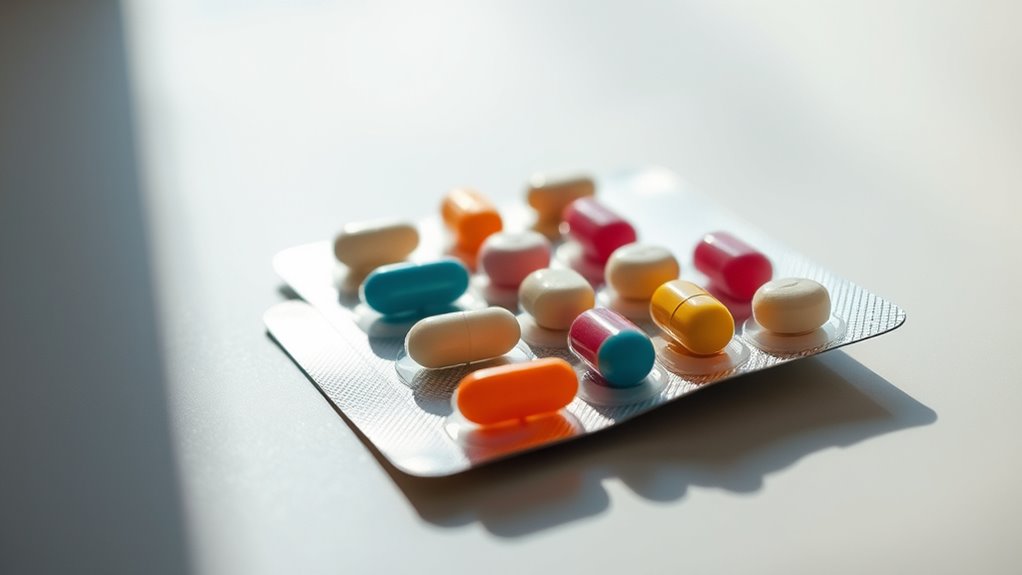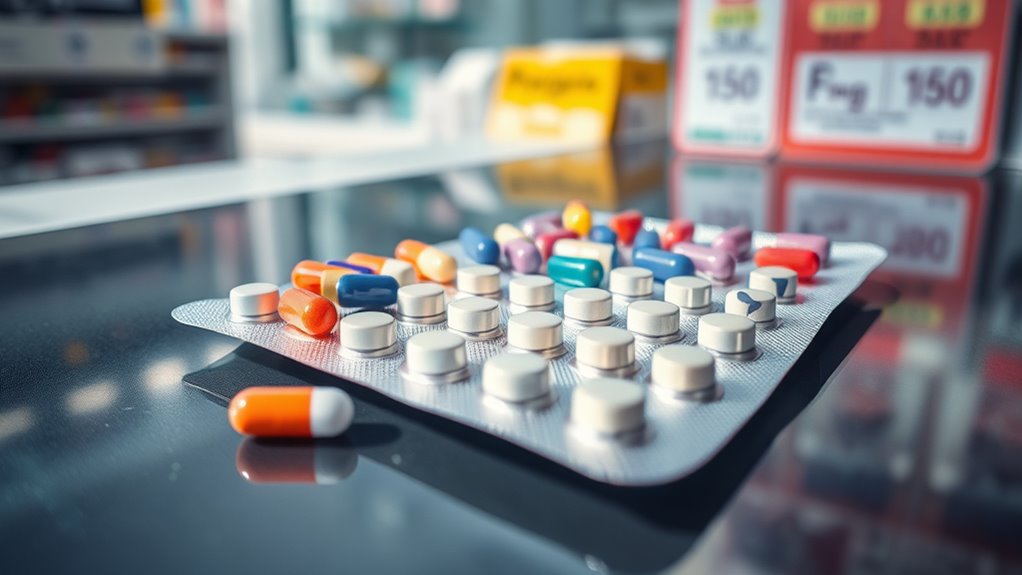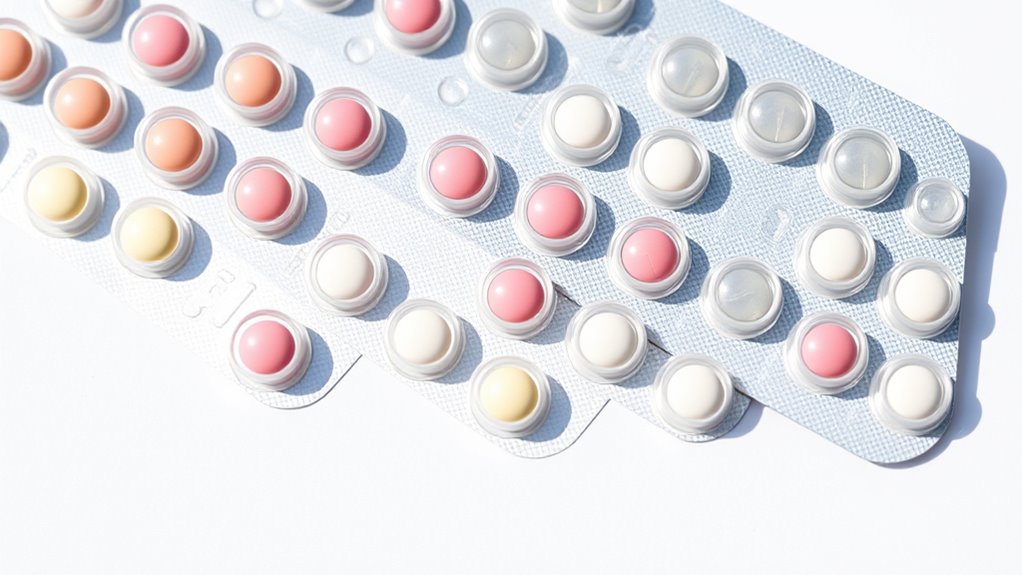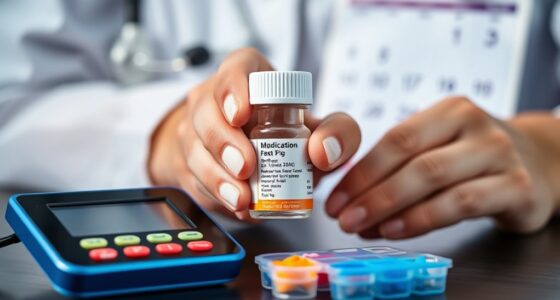Blister‑pack medications help you stay organized, making it easier to follow your dosing schedule and reduce errors. They protect medicines from moisture and light, keeping them potent longer. However, they can limit flexibility for dose adjustments and pose environmental concerns due to difficult-to-recycle materials. Proper storage and disposal are essential to avoid safety risks. To learn more about balancing these advantages and challenges, keep exploring the details below.
Key Takeaways
- Blister packs enhance medication adherence by providing organized, easy-to-use compartments that reduce dosing errors and improve compliance.
- They help preserve drug potency and extend shelf life by protecting medications from moisture, light, and air.
- Blister packs pose environmental concerns due to difficult-to-recycle multilayer plastics and metals, contributing to waste pollution.
- Fixed-dose blister packs limit flexibility for dose adjustments, making them less suitable for patients with changing medication needs.
- Proper storage and disposal are essential to maintain medication efficacy and reduce environmental and health risks associated with waste.
Advantages of Blister-Pack Medications

Blister-pack medications offer several advantages that make them a popular choice for both manufacturers and consumers. One key benefit is their ability to extend medication shelf life by protecting pills from moisture, light, and air, which helps maintain drug potency over time. This preservation reduces waste and ensures you receive effective treatment. Additionally, blister packs enhance patient education by providing clear, easy-to-understand packaging that displays dosage instructions and expiry dates directly on the pack. This improves adherence and minimizes errors, especially for those managing multiple medications. The organized layout also helps you keep track of doses and medication schedules. Furthermore, the presence of signs of spoilage such as mold or separation in the packaging can alert consumers to discard expired or compromised medication. Overall, blister packs streamline medication management, promote safety, and guarantee the integrity of your medicine throughout its shelf life.
Disadvantages of Blister-Pack Medications

While blister packs protect your medication, they also create a lot of packaging waste that can harm the environment. You might find that blister packs limit your flexibility in adjusting doses, especially if you need to take medication irregularly. These disadvantages can impact both convenience and sustainability. Additionally, some blister packs are not designed for optimal storage conditions, which can affect medication efficacy over time.
Packaging Waste Generation
Despite their convenience, blister-pack medications contribute markedly to packaging waste, creating environmental concerns. The packaging materials used are often difficult to recycle, leading to recycling challenges. The plastic and foil components are typically multilayered, making separation complex and costly. As a result, many blister packs end up in landfills or as litter, where they can take years to decompose. This waste adds to environmental pollution and strains waste management systems. Additionally, the production of blister packs consumes significant resources, including plastics and metals, increasing their ecological footprint. The complexity of recycling multilayered materials makes sustainable disposal challenging. While these packaging materials protect medications effectively, their disposal poses sustainability issues. Reducing waste generation from blister packs requires better recycling solutions and the development of eco-friendly packaging alternatives.
Reduced Flexibility in Dosing
One significant drawback of blister-pack medications is their limited flexibility in dosing. Since each blister contains a fixed dose, you can’t easily adjust the amount you take if your doctor changes your prescription or if you need a lower or higher dose. This lack of dose customization can hinder your ability to fine-tune medication intake based on your specific needs. It also reduces your patient independence, as you’re more dependent on healthcare providers for dose adjustments rather than making small changes yourself. If you require precise dosing or need to split doses, blister packs may not accommodate those needs. This rigidity can lead to challenges in managing your medication regimen effectively, especially if your condition requires frequent dose modifications.
Impact on Medication Adherence and Compliance

Blister packs make it easier for you to stick to your medication schedule by simplifying daily doses. They help reduce mistakes, so you’re less likely to take the wrong amount or miss a dose. As a result, blister packs can improve your overall adherence and guarantee you stay on track with your treatment. Additionally, blister packs often include medication protection, which helps maintain the medication’s stability and efficacy during storage.
Simplifies Daily Medication
Blister-pack medications make it easier for you to manage your daily medication routine by organizing doses into pre-sealed compartments. This setup acts like a built-in pill organizer, reducing the need to manually sort pills each day. With blister packs, you can easily see if you’ve taken your medication, helping you stay on track. They also support medication synchronization, allowing you to take all your doses at the right times without juggling multiple bottles. This simplifies your daily schedule, making medication adherence more straightforward. Instead of searching for pills or worrying about missed doses, blister packs provide a clear, organized system that keeps you consistent. As a result, they improve your confidence and comfort in managing your medications daily. Regularly reviewing your medication plan and understanding its cultural significance can further enhance adherence and overall health management.
Reduces Dosing Errors
Because blister packs organize your medication into clearly marked compartments, they considerably reduce the risk of dosing errors. The clear labels and compartmentalization help you quickly identify each dose, minimizing confusion. This visual organization supports better patient education, making it easier for you to understand when and how to take your medications correctly. Additionally, the label clarity on blister packs provides essential information at a glance, reducing misunderstandings caused by illegible or confusing instructions. As a result, you’re less likely to take the wrong dose or miss a dose altogether. By simplifying the medication process and offering straightforward visual cues, blister packs play a crucial role in ensuring you follow your prescribed regimen accurately, ultimately improving your medication safety and effectiveness. Incorporating Pimple Patches into your skincare routine can also help prevent and manage breakouts more effectively.
Enhances Routine Compliance
When your medications are organized into blister packs, it becomes easier to stick to your routine consistently. The clear packaging helps you with pill identification, ensuring you take the right medication at the right time. This visual cue reduces missed doses and promotes adherence. Additionally, blister packs support patient education by providing a straightforward way to track your medication schedule. They make it simple to see if you’ve taken your doses today, reinforcing good habits. The organized format minimizes confusion and helps you stay on top of complex regimens. Overall, blister packs boost routine compliance by making medication management more intuitive and less error-prone. With these benefits, you’re more likely to follow your prescribed schedule accurately and consistently. Incorporating organized storage solutions such as blister packs can further enhance your medication adherence efforts by systematically managing your doses.
Storage and Environmental Considerations

Proper storage of blister-pack medications is essential to maintain their effectiveness and safety. Many medications are sensitive to temperature fluctuations, so keeping them in a consistent, cool environment helps preserve their potency. Avoid exposing blister packs to excessive heat or direct sunlight, which can degrade active ingredients. Moisture protection is equally important; store medications in a dry place to prevent deterioration caused by humidity. Using airtight containers or original packaging can help shield blister packs from moisture. Additionally, avoid storing medications in bathrooms or near sinks where humidity levels are high. By paying attention to temperature sensitivity and guaranteeing moisture protection, you help extend the shelf life of your blister-pack medications and ensure they remain safe and effective for use. Incorporating protective storage practices can further enhance medication longevity.
Cost and Accessibility Factors

Cost and accessibility substantially influence whether patients can obtain and consistently use blister-pack medications. Pricing disparities between brands and regions can make these medications unaffordable for some. Distribution challenges also limit availability, especially in rural or underserved areas. You might face higher prices due to supply chain issues or limited insurance coverage. Additionally, pharmacy stock shortages can delay treatment. Analysis of competitor strategies can also inform pricing and distribution approaches. Furthermore, variations in pricing across different pharmacies, limited availability in remote locations, insurance coverage gaps increasing out-of-pocket costs, distribution challenges causing delays or shortages, and cost barriers deterring consistent use—these factors directly impact your ability to access blister-pack medications regularly and affordably, emphasizing the importance of addressing disparities and logistical hurdles to improve treatment adherence.
Safety and Waste Management Aspects

As you consider the challenges of accessing blister-pack medications, ensuring their safe use and proper disposal becomes equally important. Disposal challenges arise because blister packs are often made of plastic and aluminum, making them difficult to recycle or dispose of properly. If not handled correctly, these packs pose contamination risks, especially when discarded improperly. You need to follow guidelines for safe disposal to prevent environmental harm and reduce the risk of medication misuse. Always check local regulations for medication waste and use designated disposal bins or take-back programs. Properly managing blister packs minimizes contamination risks and supports health safety. Additionally, the recyclability of blister packs varies depending on local recycling facilities, so verifying whether they can be recycled in your area is crucial. By staying vigilant about disposal practices, you help protect the environment and prevent accidental ingestion or misuse.
Frequently Asked Questions
How Do Blister Packs Affect Medication Recycling Programs?
You might not realize it, but blister packs impact medication recycling programs substantially. Their plastic and aluminum components create recycling challenges because they often need to be separated properly, which isn’t always easy. This can increase environmental impact since many blister packs end up in landfills instead of being recycled. To improve recycling efforts, you’ll need to follow specific disposal instructions and support programs that handle blister pack waste effectively.
Are Blister Packs Suitable for All Medication Types?
Did you know that blister packs are suitable for about 80% of medications? When considering packaging design, they offer convenience and dose accuracy, but not all medication types fit well. Some require special handling or packaging, which can lead to higher cost implications. So, while blister packs work great for many drugs, you should evaluate the specific medication needs before choosing this packaging type.
Do Blister Packs Influence Medication Absorption Rates?
You might wonder if blister packs influence medication absorption rates. While blister packs mainly guarantee medication stability and dosage accuracy, they don’t directly affect how your body absorbs the medication. Proper storage in blister packs helps keep the medication effective, but absorption depends on factors like the medication’s formulation and your digestion. So, blister packs support stability and accurate dosing, but absorption rates are primarily influenced by other physiological factors.
How Do Blister Packs Impact Patient Privacy?
Imagine reaching into your bag and feeling the smooth, opaque surface of blister packs, shielding your medication from prying eyes. Blister packs enhance patient privacy by reducing packaging transparency, making it harder for others to see what’s inside. This discreet packaging allows you to carry and store medications confidently, protecting your confidentiality and ensuring your personal health details stay private. You feel secure knowing your medication is discreetly packaged.
Are There Specialized Blister Packs for Pediatric Use?
You’ll find that specialized blister packs for pediatric use often feature child-friendly packaging, making medication easier and safer for kids. These pediatric formulations are designed to be more appealing and easier to open, helping guarantee proper dosage and adherence. Manufacturers focus on creating child-safe blister packs that reduce accidental ingestion, providing peace of mind for caregivers. So, yes, there are tailored blister packs specifically designed to meet the needs of children.
Conclusion
While blister packs offer convenience and safety, they also bring challenges like environmental impact and cost. You might find yourself appreciating their role in medication management, yet occasionally questioning their sustainability. Coincidentally, as technology advances, new solutions emerge that could address these drawbacks, making blister packs both beneficial and limited. Ultimately, understanding both sides helps you make informed choices, balancing convenience with environmental and financial considerations in your healthcare journey.









